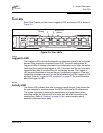
2 – General Description
Port LEDs
2-6 59021-07 A
D
2.3.1
Small Form-Factor Pluggable (SFP) Transceivers
An SFP transceiver, like the one shown in Figure 2-6, converts electrical signals to
and from optical laser signals to transmit and receive data. SFP transceivers plug
into the ports; duplex fiber optic cables plug into the transceivers which then
connect to the devices. A port is capable of transmitting at 1 Gbps or 2 Gbps;
however, the transceiver must be capable of 2 Gbps for the port to deliver at that
rate.
The SFP transceivers are hot swappable. This means that you can remove or
install an SFP transceiver while the switch is operating without harming the switch
or the transceiver. However, communication with the connected device will be
interrupted. Refer to ”SFP Transceivers” on page 6-2 for information about
installing and removing SFP optical transceivers.
Figure 2-6. SFP Transceiver
2.3.1.1
Port Modes
SANbox2-16 switches support the following port modes:
Generic ports (GL_Port and G_Port)
Fabric ports (FL_Port and F_Port)
Expansion ports (E_Port)
Switches come from the factory with all ports configured as GL_Ports. GL_Ports
self-configure in the following ways:
FL_Port when connected to a loop of public devices
F_Port when connected to a single public device. If the device is a single
device on a loop, the GL_Port will attempt to configure first as an F_Port,
then if that fails, as an FL_Port.
E_Port when connected to another FC-SW-2 compliant switch


















